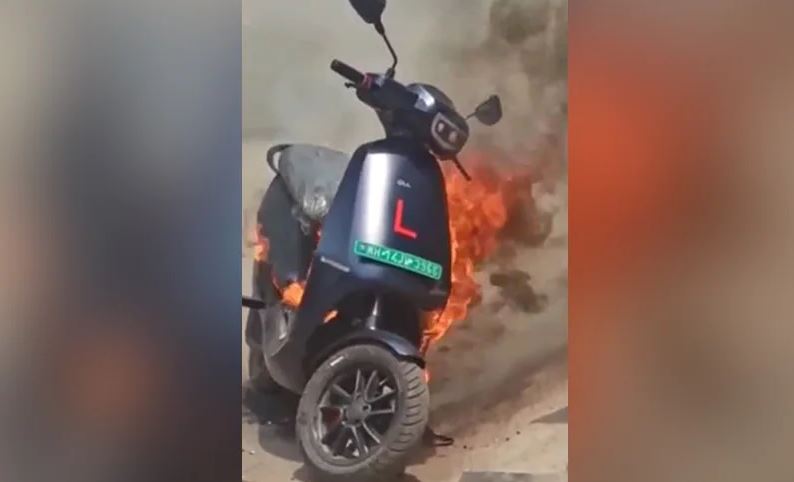
The Union government has constituted an expert panel to probe the recent series of battery explosions in electric vehicles (EVs).
Why is the world poised to transition to electric vehicles?
- The growing concern over climate change has led to global efforts to electrify the transportation sector.
- In parallel, cost of Li-ion (Lithium-ion) battery technology has decreased by a staggering order of magnitude in the past decade.
- The convergence of these two factors has resulted in a unique time in our history where we are at the cusp of a dramatic transition in the transportation sector.
- There are multiple trade-offs in this complex ecosystem: engineering higher safety often results in higher costs and lower driving range.
- In this competitive landscape where companies are vying for market share, a race to the bottom can compromise safety.
A race to nowhere
- The world has taken note of this moment with governments providing incentives to usher in the transition and private industry ramping up plans for capturing the market.
- There is a worldwide race emerging, with vehicle companies, battery manufacturers, and material suppliers vying with each other for market share.
- However, Li-ion batteries are complex devices requiring a level of sophistication that can takes years to perfect.
- Hurrying the development of this complex technology without careful safeguards are leading to increasing safety incidents, as evidenced recently on Indian roads.
What goes into a Li-ion battery?

- Every Li-ion battery consists of three active components:
- Anode: typically graphite
- Cathode: based on a nickel, cobalt, and manganese-based oxide; and
- Electrolyte: A salt of lithium in an inorganic solvent
- Battery cells are assembled into modules and then further assembled into packs.
- Li-ion batteries require tight control on the state of charge and the temperature of operation to enhance safety and increase usable life, achieved by adding multiple sensors.
- Packs are designed to ensure uniform temperature profile with minimal thermal variation during operation.
What is the level of precision involved?
- Battery manufacturing is a complex operation involving forming sheets of the anode and cathode and assembling them into a sandwich structure held apart by a thin separator.
- Separators, about 15 microns in thickness — about a fifth of the thickness of the human hair — perform the critical function of preventing the anode and cathode from shorting.
- Accidental shorting of the electrodes is a known cause of fires in Li-ion cells.
- It is important that the various layers are assembled with high precision with tight tolerances maintained throughout the manufacturing process.
- Safety features, such as thermal switches that turn off if the battery overheats, are added as the sandwich is packaged into a battery cell.
What causes battery fires?

- Battery fires, like other fires, occur due to the convergence of three parts of the “fire triangle”: heat, oxygen, and fuel.
- If an adverse event such as a short circuit occurs in the battery, the internal temperature can raise as the anode and cathode release their energy through the short.
- This, in turn, can lead to a series of reactions from the battery materials, especially the cathode, that release heat in an uncontrolled manner, along with oxygen.
- Such events also rupture the sealed battery further exposing the components to outside air and the second part of the fire triangle, namely, oxygen.
- The final component of the triangle is the liquid electrolyte, which is highly flammable and serves as a fuel.
- The combination leads to a catastrophic failure of the battery resulting in smoke, heat, and fire, released instantaneously and explosively.
What triggers battery fire?
- The trigger for such events can be a result of internal shorts (like a manufacturing defect that results in sharp objects penetrating the separator).
- The external events may be accident leading to puncture of the cell and shorting of the electrodes, overcharging the battery.
- Any of these triggers may cascade into a significant safety incident.
Are battery fires inevitable?
- Over the past three decades, Li-ion batteries have proved to be extremely safe, with the industry increasing controls as safety incidents have surfaced.
- Safety is a must and is an important consideration that battery and vehicle manufacturers can design for at multiple levels from the choice of battery material to designs at the cell, pack, and vehicle level.
- Protecting the cell with robust thermal management is critical, especially in India where ambient temperatures are high.
- Finally, battery packs need to be protected from external penetration.
- Any large-scale manufacturing process inevitably has a certain percentage of defects; therefore, such steps are needed to minimise the number of adverse events.
Why battery safety matters?
- Safety remains a concern for Li-ion manufacturers worldwide especially as cell sizes become larger for applications such as solar-connected storage.
- There is a need to remove the threat of battery fires as the roll out of mass electrification takes place.
UPSC 2023 countdown has begun! Get your personal guidance plan now! (Click here)
Get an IAS/IPS ranker as your 1: 1 personal mentor for UPSC 2024
